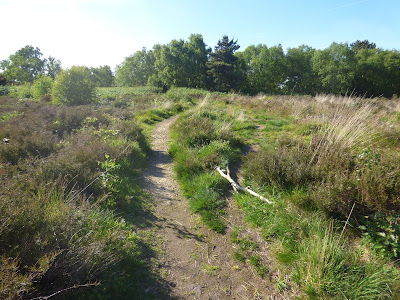Brimstone butteries were first recorded breeding in Wirral at
New Ferry Butterfly Park in 2014. Then the larva were feeding on alder buckthorn shrubs planted in 2004 by the 4th Bebington Scouts, St John’s New Ferry.
Alder buckthorn shrubs prefer damp acidic organic soils.
Since the park is on a well-drained railway site such suitable areas for alder
buckthorn to flourish are limited. The
brimstone caterpillars have expanded their menu to feed on another host plant, purging
buckthorn. These purging buckthorn shrubs
were planted in March 2014 and weeded this April by Liverpool John Moores University
Conservation Society. The freshly
exposed purging buckthorn may have been more attractive for egg laying, as the
competing vegetation was removed and the shrubs were exposed to the full sun,
which helps speed up the caterpillar’s development.
Purging buckthorn is rare a shrub in Cheshire as it prefers calcareous soils. Here at the park purging buckthorn was established on the outflows of a water softening plant, used to provide lime free to water prevent the stream engines furring up. Paul Loughnane, the Park’s secretary, said “We are delighted to see the brimstone using purging buckthorn at the park. It will enhance the breeding success of the brimstone butterfly tremendously and the butterfly experience for our visitors. Brimstone butterflies have been restricted locally by the absence of larval food plants. Once the plants are established in a sunny and sheltered aspect, the brimstones have an opportunity to colonise these areas. I know of only one other record of them breeding on purging buckthorn in Cheshire and that was in a garden in Alderley Edge in 2010. The male brimstone is a large yellow butterfly, a strong flyer and can be easily recognised at a distance. These butterflies will be on the wing in July.”
 |
| Brimstone butterfly feeding on Red Campion. Photo: Paul Loughnane |
Interest in the caterpillars is not only restricted
to human visitors, the Bronze shield bug (Troilus luridus),
sometimes known as the Stealth shield bug, has expanded its menu at the park to
brimstone caterpillars. It creeps up
upon the unsuspecting caterpillar and, using it mouth parts which are shaped like
a syringe, stabs the caterpillar and sucks out its innards. One of the distinguishing features of this shield bug is the
orange band on the penultimate segment of each antenna, which can be clearly
seen in the photograph. This is the first
record of a Bronze shield bug in Wirral. Thanks to John McGaw, Wirral Wildlife Invertebrate Recorder, for identifying
this shield bug. John, who has never
seen this shield bug species before, commented “A really interesting find, but for the sake of
the butterfly population in the park let's hope there are not too many of them
around!”
 |
| 12 June. Caterpillar attacked by shield bug. |




















